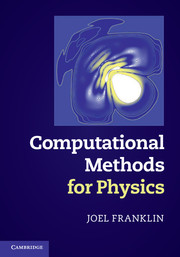Book contents
- Frontmatter
- Dedication
- Contents
- Preface
- 1 Programming overview
- 2 Ordinary differential equations
- 3 Root-finding
- 4 Partial differential equations
- 5 Time-dependent problems
- 6 Integration
- 7 Fourier transform
- 8 Harmonic oscillators
- 9 Matrix inversion
- 10 The eigenvalue problem
- 11 Iterative methods
- 12 Minimization
- 13 Chaos
- 14 Neural networks
- 15 Galerkin methods
- References
- Index
7 - Fourier transform
Published online by Cambridge University Press: 05 July 2013
- Frontmatter
- Dedication
- Contents
- Preface
- 1 Programming overview
- 2 Ordinary differential equations
- 3 Root-finding
- 4 Partial differential equations
- 5 Time-dependent problems
- 6 Integration
- 7 Fourier transform
- 8 Harmonic oscillators
- 9 Matrix inversion
- 10 The eigenvalue problem
- 11 Iterative methods
- 12 Minimization
- 13 Chaos
- 14 Neural networks
- 15 Galerkin methods
- References
- Index
Summary
The Fourier transform plays a major role in the solution of ordinary and partial differential equations, and so is of theoretical utility in physics. Just as important is its applications to data analysis, and signal processing, making the Fourier transform an indispensible tool in experimental physics as well. The reason for its centrality is the connection the transform makes between temporal data and frequency information. A time-varying sinusoidal signal may have complicated patterns of repetition, and yet be made up of only a few frequencies. A signal with ten thousand data points may be describable in terms of two or three frequency values. We know how the frequencies combine, so we can reconstruct the signal.
Where do physical oscillations come from? The harmonic potential shows up far more than its springy roots would imply. Any local minimum in a complicated potential has an effective spring constant, and that effective spring constant determines a time scale of oscillation, i.e. a period (whose inverse defines the frequency). If we know the frequencies associated with a signal, then, we know something about the local minimum defined by some complicated potential.
There is also a human element to the Fourier transform. Much of the information we process can be described in terms of frequencies – both light and sound come to mind. So our ability to isolate and manipulate the individual frequencies of physiological input can lead to interesting changes in perception.
Information
- Type
- Chapter
- Information
- Computational Methods for Physics , pp. 172 - 198Publisher: Cambridge University PressPrint publication year: 2013
